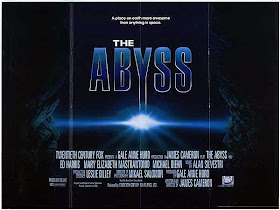“There is something down there! Something
not us.”
This month
marks the 25th anniversary of James Cameron’s THE ABYSS.
Even before
he became the undisputed king of the box office, James Cameron was making a
name for himself as an innovative and visionary director, thanks to his
landmark sic-fi films THE TERMINATOR (1984) and ALIENS (1986). His newest film,
a story about a team of underwater oil-workers who encounter a mysterious
species, would be his most ambitious yet.
Inspired by
a story which he wrote when he was just 17 years told, Cameron’s THE ABYSS
would require over 40% of the film to be shot underwater. The ambitious vision
required the entire cast to become certified divers, and for one of the most
massive and elaborate practical sets in history to be built. The set which
would serve as the Deep Core mining
rig was built in an abandoned nuclear power plant in two specially constructed
tanks which took five days to fill with water. It would take half a year to
plan and build.
Filming
pushed the limits of technology. Specially designed camera-housings had to be
designed and built, and custom underwater diving helmets also had to be created
so the actors’ faces could be seen. These techniques not only paid off for the
high quality of production that THE ABYSS would have, but would also be
utilized in future films; from Cameron’s own TITANIC in 1997 to Wes Anderson’s
THE LIFE AQUATIC WITH STEVE ZISSOU in 2004.
Filming,
which consisted of six months of six-day, 70-hour work-weeks on an isolated
set, also pushed the limits of the crew and actors. Stars Ed Harris and Mary
Elizabeth Mastrantonio suffered emotional breakdowns, and divers suffered skin
burns from the heavy amounts of chlorine in the tanks. Cast and crew would
nickname the production “The Son of The Abyss”, while Cameron himself stated
that the film was the most difficult he had ever worked on. The famed visual-effects
house Industrial Light and Magic spent six months creating 75 seconds of
computer graphics to create a sea creature composed of water, with the result
opening up the door for a new generation of CGI wizardry.
THE ABYSS
opened with moderate success at the box office and even better success with the
critics. It would win the Oscar for Best Visual Effects, and would earn
nominations for Best Art Direction, Best Cinematography, and Best Sound. It
would also win awards from the Academy of Science Fiction, Fantasy & Horror
Films, and the American Society of Cinematographers.
*
Aside from
inventing new tech that the industry would embrace, THE ABYSS deserves credit
as a cinematic adventure. It is essentially a science fiction film using the
oldest of stories of human-meets-alien and makes it work in a setting that we
had never seen before; it would be an approach that Cameron would use again in
AVATAR (2009). What he learned on THE ABYSS he would carry over into his
TERMINATOR sequel (1991), and what he learned there he took on board his
historic TITANIC (1997). His time on the high-seas would inspire his
second-career as a deep sea diver and documentarian, and that would in turn
bring him and the industry where it is today. Great films move the industry
forward, and perhaps the modern era began by plunging into THE ABYSS.
“Luck is not a factor.”

No comments:
Post a Comment
A few rules:
1. Personal attacks not tolerated.
2. Haters welcome, if you can justify it.
3. Swearing is goddamn OK.